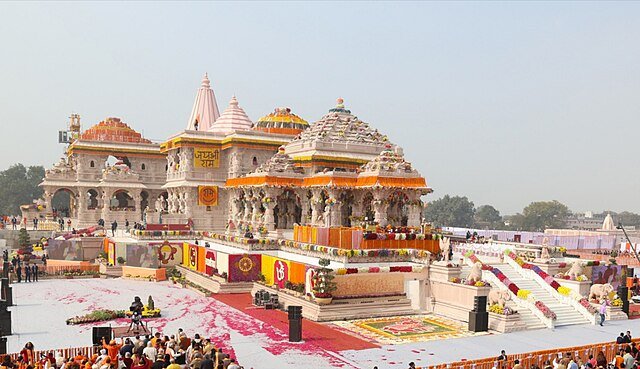1.Introduction
-
- Brief overview of Ayodhya
- Importance of exploring diverse places
- Ram Janmabhoomi Temple
- Historical significance
- Architectural marvels
- Pilgrim’s perspective
- Hanuman Garhi
- Spiritual significance
- Stunning architecture
- Pilgrim experiences
- Kanak Bhavan
- Mythological connections
- Artistic beauty
- Cultural importance
- Treta Ke Thakur
- Historical relevance
- Religious practices
- Serenity and peace
- Moti Mahal
- Unique blend of architecture
- Historical anecdotes
- Restoration efforts
- Guptar Ghat
- Riverside beauty
- Religious rituals
- Scenic views
- Nageshwarnath Temple
- Ancient history
- Architectural charm
- Local beliefs
- Ramkot
- Fort with historical significance
- Panoramic views
- Connection to Lord Rama’s reign
- Tulsi Smarak Bhawan
- Tribute to Tulsidas
- Literary significance
- Tranquil surroundings
- Ayodhya Art Gallery
- Preserving cultural heritage
- Unique artifacts
- Artistic expressions
- Lakshman Ghat
- Riverside charm
- Spiritual aura
- Recreational activities
- Sita Ki Rasoi
- Mythological tales
- Culinary traditions
- Pilgrim’s delight
- Ayodhya Archaeological Museum
- Uncovering ancient artifacts
- Historical insights
- Educational experiences
- Conclusion
- Summarize the beauty and diversity of Ayodhya
- Encourage readers to explore these gems
10 BEST Places to Visit in Ayodhya
Introduction
Nestled along the banks of the Sarayu River, Ayodhya stands as a city steeped in rich history and cultural significance. As we embark on a journey through the heart of this sacred city, let’s uncover the 10 best places that showcase Ayodhya’s unique charm and spiritual aura.
Ram Janmabhoomi Temple
Historical Significance The iconic Ram Janmabhoomi Temple holds the key to Ayodhya’s historical legacy. Believed to be the birthplace of Lord Rama, the temple stands as a testament to ancient Indian architecture and religious devotion. Pilgrims flock to experience the divine connection and marvel at the intricate carvings adorning the temple’s structure.
Hanuman Garhi
Spiritual Significance Perched atop a hill, Hanuman Garhi offers not only panoramic views of Ayodhya but also a profound spiritual experience. The temple dedicated to Lord Hanuman boasts stunning architecture and attracts devotees seeking blessings and a serene atmosphere for meditation.
Kanak Bhavan
Mythological Connections Kanak Bhavan, a gem in Ayodhya’s crown, has deep mythological roots associated with Lord Rama and his consort Sita. The palace-turned-temple showcases artistic beauty and remains a symbol of cultural importance, drawing visitors from far and wide.
Treta Ke Thakur
Historical Relevance Treta Ke Thakur, a lesser-known yet historically significant spot, offers a glimpse into Ayodhya’s ancient past. The site, associated with religious practices dating back centuries, exudes serenity and peace, providing a retreat for spiritual seekers.
Moti Mahal
Unique Blend of Architecture Moti Mahal, with its unique blend of architectural styles, stands as a testimony to Ayodhya’s royal history. Steeped in anecdotes from the past, the palace reflects the grandeur of bygone eras while efforts to restore its glory continue.
Guptar Ghat
Riverside Beauty Guptar Ghat, situated along the serene banks of the Sarayu River, offers a picturesque setting for religious rituals and introspection. The ghat’s beauty, coupled with its historical significance, makes it a must-visit spot for tourists seeking tranquility.
Nageshwarnath Temple
Ancient History Nageshwarnath Temple, with its ancient roots, adds to Ayodhya’s architectural charm. Locals hold deep beliefs in the sanctity of the temple, making it a spiritual haven for those seeking divine blessings.
Ramkot
Fort with Historical Significance Ramkot, a fort with historical significance dating back to Lord Rama’s reign, provides panoramic views of Ayodhya. The site is not only a historical gem but also a testament to the city’s enduring legacy.
Tulsi Smarak Bhawan
Tribute to Tulsidas Tulsi Smarak Bhawan pays homage to the great poet Tulsidas. The building’s architecture and tranquil surroundings make it a place of literary significance and a retreat for those seeking solace.
Ayodhya Art Gallery
Preserving Cultural Heritage Ayodhya Art Gallery stands as a guardian of the city’s cultural heritage, housing unique artifacts that narrate tales of the past. Visitors can immerse themselves in artistic expressions that transcend time.
Lakshman Ghat
Riverside Charm Lakshman Ghat, with its riverside charm, invites visitors to bask in the spiritual aura and engage in recreational activities. The ghat is not only a religious site but also a spot for relaxation and reflection.
Sita Ki Rasoi
Mythological Tales Sita Ki Rasoi, steeped in mythological tales, offers a culinary journey intertwined with religious traditions. Pilgrims delight in the flavors and stories that echo the times of Lord Rama and Sita.
Ayodhya Archaeological Museum
Uncovering Ancient Artifacts The Ayodhya Archaeological Museum serves as a gateway to the city’s past, uncovering ancient artifacts that tell tales of bygone eras. The museum provides historical insights and educational experiences for curious minds.
Conclusion
As we conclude our journey through the 10 best places to visit in Ayodhya, the city’s beauty and diversity become evident. Ayodhya, with its rich history and spiritual significance, invites travelers to explore its cultural gems and connect with the ancient roots that define its essence.
Unearth the magic of Ayodhya, where every corner tells a story and every temple echoes with the chants of devotion. Plan your visit and immerse yourself in the spiritual and historical tapestry that makes Ayodhya a truly unique destination.
FAQs
- Is Ayodhya only known for its religious significance?
- No, Ayodhya also boasts a rich historical and cultural heritage beyond its religious sites.
- Are these places suitable for all age groups?
- Yes, the diverse attractions cater to visitors of all ages, offering a blend of spirituality, history, and recreation.





